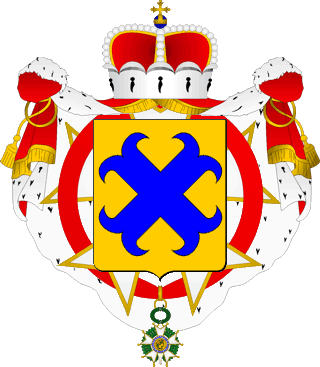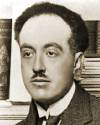

Louis de Broglie (1892-1987) French physicist
Duc de Broglie, Prince de Broglie et du Saint-Empire
[Prince then Duke in 1960] Nobel 1929
The above picture
(reproduced here by permission) is from the
Maison
de Broglie page of the superb site
Héraldique européenne.
Copyright © 1997-2007
by Arnaud Bunel. All rights reserved.
Or, a saltire moline Azure.
Crest :
A Swan issuant. Pendant from a ribbon Gules
around its neck, a saltire as in the arms.
Supporters :
Two Lions guardant crowned Or langued Gules.
All within a manteau ermine doubled Or semy of saltires as in the arms.
D'or au sautoir [ alaisé et ] ancré d'azur.
The de Broglie
family was originally from Piedmont. The head of the family bears the Ducal title awarded by Louis XV in 1742
to François-Marie de Broglie (1661-1745).
His son Victor François,
second Duke de Broglie, (1718-1804) was also made a Prince of the Holly Empire in 1759.
The family tradition was instituted to let the heir apparent bear the latter title until he becomes head of the family
(the physicist Louis de Broglie was thus known as "Prince de Broglie" until 1960).
The sixth duke de Broglie was the older brother of Louis,
Maurice de Broglie (1875-1960)
who resigned his Navy commission in 1904 to
work as a physicist under Paul Langevin.
Using family funds, Maurice created a private X-ray laboratory in 1908, where he mentored
successful physicists like his younger brother, Louis de Broglie, future Nobel laureate,
and
Louis Leprince-Ringuet
(1901-2000; X1920n) who went on to hold one of the two
historical chairs of physics at Polytechnique, for 33 years (1936-1969).
Leprince-Ringuet was instrumental in creating a third chair (for Bernard P. Grégory) in 1958.
When Maurice passed away in 1960, Louis de Broglie took over as seventh Duke and head of the family
(the ducal title went to
Victor-François
de Broglie (1949-2012) when Louis died, in 1987).

In 1923, Louis de Broglie was still a graduate
student at the Sorbonne when he proposed the idea of
matter waves,
which he defended successfully in 1924 (with the support of
Einstein himself)
in front of a doctoral committee which included
Paul Langevin (1872-1946).
At the time, de Broglie stated that his proposed matter waves might
be observable in experiments involving the diffraction of electrons beams by crystals...
Such experimental confirmations came in 1927, with two independent experiments:
one by Clinton J. Davisson (1881-1958;
Nobel 1937)
and Lester H. Germer (1896-1971), the other by G.P. Thomson (1892-1975;
Nobel 1937)...
Ironically, George Paget Thomson thus demonstrated the undulatory nature of
electrons, whose corpuscular properties had been established three decades earlier
by his own father, J.J. Thomson
(1856-1940; Nobel 1906).



